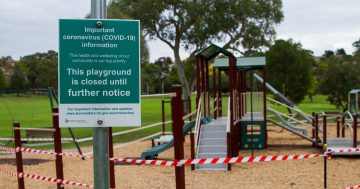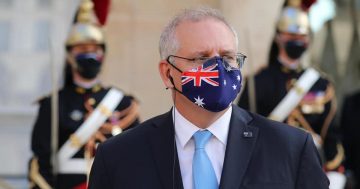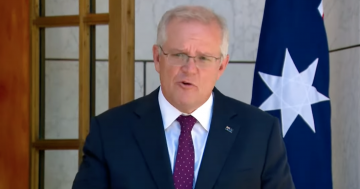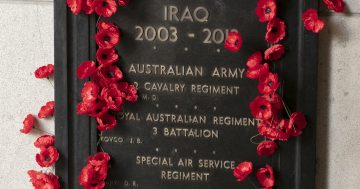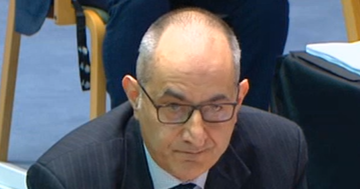
Prime Minister Scott Morrison is working to a political timetable. Photo: Facebook.
Just why did Scott Morrison pick up the megaphone and crowbar this week to, in his words, make a lot of noise about the road out of lockdowns to a ‘new dawn’?
He says it’s about hope, but it is worth remembering that his government is facing an election soon.*
That’s why he has confected this brawl about COVID lockdowns and restrictions between the Commonwealth and the states, and provides some cover for Gladys Berejiklian’s tragically inept performance managing the Delta epidemic in NSW that has allowed it to spread to the ACT, Victoria, Queensland and New Zealand.
Mr Morrison, who has been all over the shop on COVID, says it’s now all about vaccination and has accused Labor states WA and Queensland of dragging their feet on getting jabs into people’s arms.
This from the bloke responsible for not covering all the vaccine bases in the first place, the subsequent strollout and the now-infamous “it’s not a race” comment.
He’s also warned the states to stick to the agreed National Plan on opening up the country once vaccination rates hit the milestones of 70 and 80 per cent, saying they won’t be able to depend on Commonwealth financial support if they don’t play ball.
He’s even weaponised the Doherty Institute, trumpeting their modelling that shows that you can open up at these vaccination rates with cases still high.
It’s been a slick week of soft morning show and radio interviews in which he has employed all the skills of a carnival barker. He has been selective in his facts, glossed over important details, played down others, ignored the continuing NSW trainwreck and verballed his fellow leaders in National Cabinet.
Chief Minister Andrew Barr – who has been a model of calm, factual reassurance during the ACT lockdown – has refused to take the bait, simply pointing out just what the Plan actually says.
The four-phase plan does not say we can wave goodbye to lockdowns or restrictions, not until the post-vaccination phase, at least.
From 70 to 80 per cent vaccination, the Plan still includes ongoing low-level restrictions, possible lockdowns and any easing of restrictions on the vaccinated to be determined.
The next phase after 80 per cent still includes ongoing baseline restrictions and may still involve highly targeted lockdowns.
So there is built-in flexibility in the Plan, at the request of the states and territories which obviously do not want to be locked into a uniform approach that might not suit their particular circumstances.
The Doherty modelling also assumes that ongoing public health measures such as social distancing and mask-wearing will be needed to support vaccination.
Other modelling suggests that the Prime Minister’s approach could cost thousands of lives.
Mr Morrison’s vaccination push only includes the adult population, but Mr Barr says children over the age of 12 must be included in the vaccination data, particularly with Delta ravaging the young, and this will figure in the ACT’s thinking on its future public health settings.
Mr Barr’s other point is that leaders should be talking about effective vaccination (that is, three weeks after the second jab, when protection hits its high point).
“Delta does not listen to chief ministers, premiers, or prime ministers,” Mr Barr told a press conference this week.
In other words, it doesn’t adhere to a political timetable.
Mr Morrison has decided to amplify the differences rather than what all jurisdictions agree on and so desperately want for their people and businesses.
It is laughable to suggest that the Labor state leaders do not want to open their borders, their economies to be back on track, and people to move freely again.
Tourism-reliant Queensland would give almost anything to have the planes landing again. The ACT has just cancelled for the second year in a row its biggest moneyspinner, Floriade, as the tourism industry it has nurtured lies in ruins.
Mr Barr and the premiers all know vaccination, together with public health measures, is the way out, and vaccine supply, controlled by the Commonwealth, has always been the issue.
But Mr Morrison knows people are weary, particularly in seat-rich Victoria and NSW, and want to see an endpoint to it all.
So he is attempting to regain the political initiative, reassert the Commonwealth’s primacy, corral the states, wedge hapless Albo and be the man who led us out of lockdown to a post-COVID future, just in time for a grateful populace to return his government.
It’s a high-wire strategy. There are real lives at stake, and states such as Queensland and WA have rewarded their government handsomely for their tough stances.
Unfortunately, his attempt to shift the narrative in his favour offers false hope and a false dawn. It only encourages the anti-lockdown element that stages counter-productive and unruly demonstrations.
But all the noise could also be just so much sound and fury.
The threat to states and territories may be hollow, for as Mr Barr says, pulling financial support with an election in the wind would be political suicide.
At this point in the pandemic, we need leaders more than ever who can stay the course, be consistent and reassure the public. Mr Morrison fails on all of these counts.
* This article originally said that the only government facing an election soon was the Prime Minister’s. This was incorrect. South Australia goes to the polls in March, 2022.












